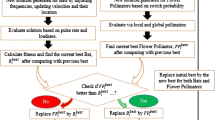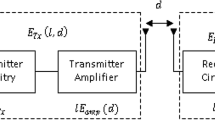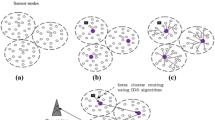Abstract
Rapid advancement of technologies in Wireless Sensor Networks is attracting maximized attention across the scientific community due to its suitability and diversified coverage in real life applications. WSNs due to their features of resource limitation and infrastructure-less deployment introduces the most challenging issues of network lifetime improvement, energy stability and reliable cluster head selection, which is still a herculean task. Clustering is an indispensable mechanism employed for selecting an optimal cluster head with the objective of extending network lifetime with energy stability that achieves efficient data transmission. Cluster head selection through meta-heuristic algorithms introduces the merits of simplicity, flexibility, derivation free and prevents local optima. In this paper, Hybrid Mutualism Mechanism-inspired Butterfly and Flower Pollination Optimization Algorithm (HMMB-FPOA) is proposed for energy‐efficient cluster head selection that attributes towards better energy stability and sustained network lifetime. Mutualism phase includes the symbiosis organisms search over flower pollination optimization algorithm for incorporating strong exploitation capability into butterfly optimization algorithm that prevents losses of premature convergence as it may lose its diversity. This integration of FPOA and BOA improves the overall exploration ability to the expected level, such that convergence speed of the algorithms is accelerated. It also balances the capabilities of exploitation and exploration by dynamically increasing the adaptive switching probability that results in prolonged network lifetime. The simulation results of HMMB-FPOA confirmed an enhanced performance of the network in terms of alive nodes, dead nodes, residual energy, overall throughput, and convergence rate on par with the existing competitive cluster head selection algorithms.














Similar content being viewed by others
Data Availability
Data sharing not applicable – no new data generated, Data sharing is not applicable to this article as no new data were created or analyzed in this study.
References
Umbreen, S., Shehzad, D., Shafi, N., Khan, B., & Habib, U. (2020). An energy-efficient mobility-based cluster head selection for lifetime enhancement of wireless sensor networks. IEEE Access, 8(2), 207779–207793.
Jia, D., Zhu, H., Zou, S., & Hu, P. (2016). Dynamic cluster head selection method for wireless sensor network. IEEE Sensors Journal, 16(8), 2746–2754. https://doi.org/10.1109/jsen.2015.2512322
Murugaanandam, S., & Ganapathy, V. (2019). Reliability-based cluster head selection methodology using fuzzy logic for performance improvement in WSNs. IEEE Access, 7(2), 87357–87368. https://doi.org/10.1109/access.2019.2923924
El Alami, H., & Najid, A. (2019). ECH: An enhanced clustering hierarchy approach to maximize lifetime of wireless sensor networks. IEEE Access, 7(2), 107142–107153. https://doi.org/10.1109/access.2019.2933052
Wang, C., & Wang, S. (2019). Research on uneven clustering APTEEN in CWSN based on ant colony algorithm. IEEE Access, 7(2), 163654–163664. https://doi.org/10.1109/access.2019.2950855
Zhu, B., Bedeer, E., Nguyen, H. H., Barton, R., & Henry, J. (2021). Improved Soft-K-Means clustering algorithm for balancing energy consumption in wireless sensor networks. IEEE Internet of Things Journal, 8(6), 4868–4881. https://doi.org/10.1109/jiot.2020.3031272
Gautam, N., & Pyun, J. (2010). Distance aware intelligent clustering protocol for wireless sensor networks. Journal of Communications and Networks, 12(2), 122–129. https://doi.org/10.1109/jcn.2010.6391368
Jain, K., & Kumar, A. (2019). An optimal RSSI-based cluster-head selection for sensor networks. International Journal of Adaptive and Innovative Systems, 2(4), 349. https://doi.org/10.1504/ijais.2019.10030287
Baskaran, M., & Sadagopan, C. (2015). Synchronous firefly algorithm for cluster head selection in WSN. The Scientific World Journal, 2015, 1–7. https://doi.org/10.1155/2015/780879
Farman, H., Javed, H., Jan, B., Ahmad, J., Ali, S., Khalil, F. N., & Khan, M. (2017). Analytical network process based optimum cluster head selection in wireless sensor network. PLoS ONE, 12(7), e0180848. https://doi.org/10.1371/journal.pone.0180848
Janakiraman, S., & Priya, M. D. (2020). An energy-proficient clustering-inspired routing protocol using improved bkd-tree for enhanced node stability and network lifetime in wireless sensor networks. International Journal of Communication Systems. https://doi.org/10.1002/dac.4575
John, J., & Rodrigues, P. (2019). A survey of energy-aware cluster head selection techniques in wireless sensor network. Evolutionary Intelligence, 2(2), 45–56. https://doi.org/10.1007/s12065-019-00308-4
Dattatraya, K. N., & Rao, K. R. (2019). Hybrid based cluster head selection for maximizing network lifetime and energy efficiency in WSN. Journal of King Saud University - Computer and Information Sciences, 2(1), 45–59. https://doi.org/10.1016/j.jksuci.2019.04.003
Shankar, T., Shanmugavel, S., & Rajesh, A. (2016). Hybrid HSA and PSO algorithm for energy efficient cluster head selection in wireless sensor networks. Swarm and Evolutionary Computation, 30(2), 1–10. https://doi.org/10.1016/j.swevo.2016.03.003
Li, X., Keegan, B., & Mtenzi, F. (2018). Energy efficient hybrid routing protocol based on the artificial fish swarm algorithm and ant colony optimisation for WSNs. Sensors, 18(10), 3351. https://doi.org/10.3390/s18103351
Rajagopal, A. (2018). Performance analysis for efficient cluster head selection in wireless sensor network using RBFO and hybrid BFO-BSO. International Journal of Wireless Communications and Mobile Computing, 6(1), 89–99.
Rajaram, V., & Kumaratharan, N. (2020). An optimized clustering using hybrid meta-heuristic approach for wireless sensor networks. International Journal of Communication Systems, 33(18).
Han, Y., Li, G., Xu, R., Su, J., Li, J., & Wen, G. (2020). Clustering the wireless sensor networks: A meta-heuristic approach. IEEE Access, 8(2), 214551–214564. https://doi.org/10.1109/access.2020.3041118
Murugadass, G., & Sivakumar, P. (2020). A hybrid elephant herding optimization and cultural algorithm for energy-balanced cluster head selection scheme to extend the lifetime in WSNs. International Journal of Communication Systems, 3(2), e4538.
Tamilarasan, N., Lenin, S., Jayapandian, N., & Subramanian, P. (2021). Hybrid shuffled frog leaping and improved biogeography-based optimization algorithm for energy stability and network lifetime maximization in wireless sensor networks. International Journal of Communication Systems, 34(4), 67–79.
Nagarajan, L., & Thangavelu, S. (2020). Hybrid grey wolf sunflower optimisation algorithm for energy-efficient cluster head selection in wireless sensor networks for lifetime enhancement. IET Communications, 15(3), 384–396.
Wang, Z., Luo, Q., & Zhou, Y. (2020). Hybrid metaheuristic algorithm using butterfly and flower pollination base on mutualism mechanism for global optimization problems. Engineering with Computers, 3(1), 45–56.
Gálvez, J., Cuevas, E., & Avalos, O. (2017). Flower pollination algorithm for multimodal optimization. International Journal of Computational Intelligence Systems, 10(1), 627. https://doi.org/10.2991/ijcis.2017.10.1.42
Sharma, S., & Saha, A. K. (2019). M-MBOA: A novel butterfly optimization algorithm enhanced with mutualism scheme. Soft Computing, 24(7), 4809–4827. https://doi.org/10.1007/s00500-019-04234-6
Sahoo, B. M., Pandey, H. M., & Amgoth, T. (2021). GAPSO-H: A hybrid approach towards optimizing the cluster-based routing in wireless sensor network. Swarm and Evolutionary Computation, 60(3), 100772.
Balamurugan, A., Priya, M. D., Janakiraman, S., & Christy, J. (2021). Hybrid stochastic ranking and opposite differential evolution-based enhanced firefly optimization algorithm for extending network lifetime through efficient clustering in WSNs. J Network System Management, 29, 1–31.
Balamurugan, A., Janakiraman, S., Priya, M. D., & Malar, A. C. (2022). Hybrid marine predators optimization and improved particle swarm optimization-based optimal cluster routing in wireless sensor networks (WSNs). China Communications, 19(6), 219–247.
Sengathir, J., Rajesh, A., Dhiman, G., Vimal, S., Yogaraja, C., & Viriyasitavat, W. (2021). A novel cluster head selection using hybrid artificial bee colony and firefly algorithm for network lifetime and stability in WSNs. Connection Science, 34(1), 387–408.
Bandi, R., Ananthula, V. R., & Janakiraman, S. (2021). Self-adapting differential search strategies improved artificial bee colony algorithm-based cluster head selection scheme for WSNs. Wireless Personal Communications, 121(3), 2251–2272.
Ali, H., Tariq, U. U., Hussain, M., Lu, L., Panneerselvam, J., & Zhai, X. (2021). ARSH-FATI: A novel Metaheuristic for cluster head selection in wireless sensor networks. IEEE Systems Journal, 15(2), 2386–2397.
Panchal, A., & Singh, R. K. (2021). EOCGS: Energy efficient optimum number of cluster head and grid head selection in wireless sensor networks. Telecommunication Systems, 3(4), 1–13.
Subramanian, P., Sahayaraj, J. M., Senthilkumar, S., & Alex, D. S. (2020). A hybrid grey wolf and crow search optimization algorithm-based optimal cluster head selection scheme for wireless sensor networks. Wireless Personal Communications, 113(2), 905–925.
Guleria, K., & Verma, A. K. (2019). Meta-heuristic ant colony optimization based unequal clustering for wireless sensor network. Wireless Personal Communications, 105(3), 891–911.
Arora, S., & Singh, S. (2017). A hybrid optimisation algorithm based on butterfly optimisation algorithm and differential evolution. International Journal of Swarm Intelligence, 3(2–3), 152–169.
Arora, S., & Singh, S. (2017). An effective hybrid butterfly optimization algorithm with artificial bee colony for numerical optimization.
Sharma, S., & Saha, A. K. (2020). m-MBOA: A novel butterfly optimization algorithm enhanced with mutualism scheme. Soft Computing, 24(7), 4809–4827.
Rambabu, B., Venugopal Reddy, A., & Janakiraman, S. (2019). Hybrid artificial bee colony and monarchy butterfly optimization algorithm (HABC-MBOA)-based cluster head selection for WSNs. Journal of King Saud University - Computer and Information Sciences, 2(2), 45–56.
Janakiraman, S. (2018). A hybrid ant colony and artificial bee colony optimization algorithm-based cluster head selection for IoT. Procedia Computer Science, 143, 360–366.
Janakiraman, S., Priya, M., Devi, S., Sandhya, G., Nivedhitha, G., & Padmavathi, S. (2018). A Markov process-based opportunistic trust factor estimation mechanism for efficient cluster head selection and extending the lifetime of wireless sensor networks. EAI Endorsed Transactions on Energy Web, 2(1), 168093.
Funding
There is no funding received for this research work.
Author information
Authors and Affiliations
Corresponding author
Ethics declarations
Conflict of interest
The authors declare that there is no competing interest.
Additional information
Publisher's Note
Springer Nature remains neutral with regard to jurisdictional claims in published maps and institutional affiliations.
Rights and permissions
Springer Nature or its licensor holds exclusive rights to this article under a publishing agreement with the author(s) or other rightsholder(s); author self-archiving of the accepted manuscript version of this article is solely governed by the terms of such publishing agreement and applicable law.
About this article
Cite this article
Pratha, S.J., Asanambigai, V. & Mugunthan, S.R. Hybrid Mutualism Mechanism-Inspired Butterfly and Flower Pollination Optimization Algorithm for Lifetime Improving Energy‐Efficient Cluster Head Selection in WSNs. Wireless Pers Commun 128, 1567–1601 (2023). https://doi.org/10.1007/s11277-022-10010-x
Accepted:
Published:
Issue Date:
DOI: https://doi.org/10.1007/s11277-022-10010-x




